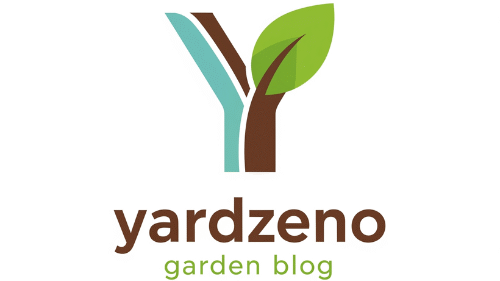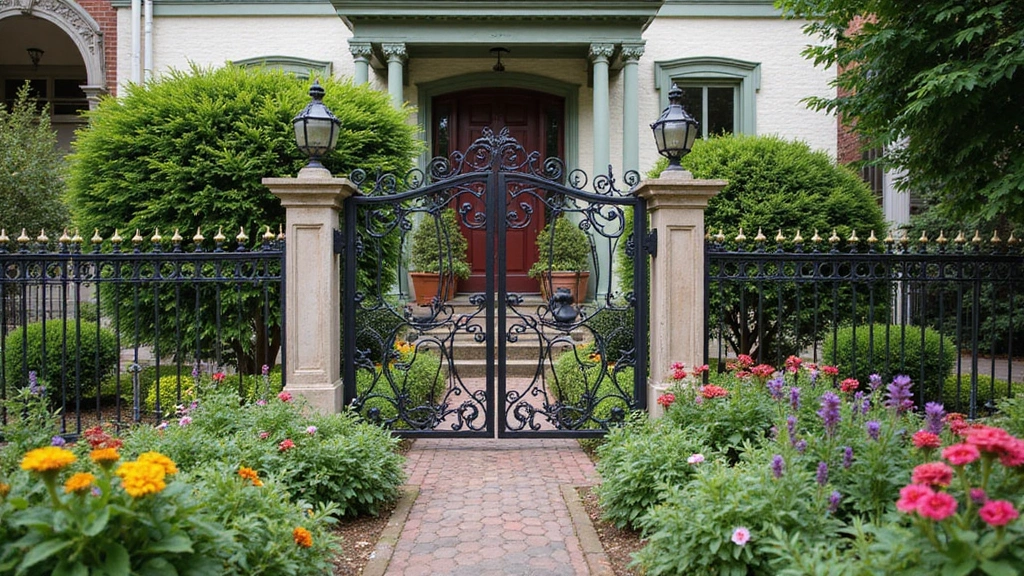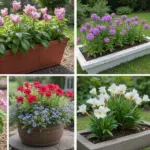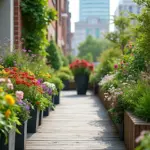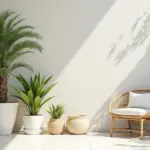Victorian front gardens are a delightful blend of elegance and charm that instantly transport you to a different era. With their intricate designs, vibrant ornamental plants, and inviting pathways, these gardens speak volumes about the Victorian love for nature and aesthetics. Whether you have a sprawling estate or a cozy little patch, there’s something special about incorporating Victorian elements into your front garden.
From ornate wrought iron gates to vintage garden decor, the possibilities are endless. This article covers 30 beautiful ideas that will inspire you to transform your small space into a Victorian wonderland. Get ready to explore gorgeous landscaping ideas that incorporate classic charm, lush greenery, and clever design tips that will ensure your front garden is the talk of the neighborhood.
1. Ornate Wrought Iron Fencing
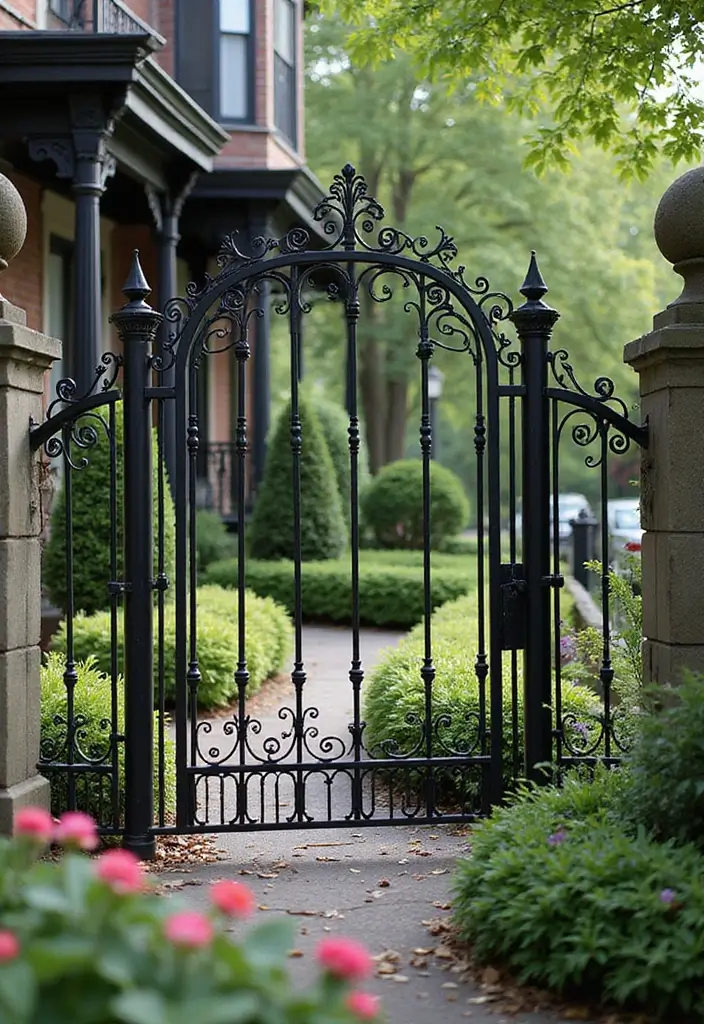
An ornamental wrought iron fence serves as a stunning backdrop to any Victorian front garden. These intricate designs not only provide security but also enhance the overall aesthetic. Choose a pattern that reflects traditional Victorian styles—think curvy, swirling designs.
Benefits include:
– Allowing visibility of your beautiful plants while offering protection.
– Creating an elegant frame for your garden.
– Elevating property value with classic charm.
Consider painting the fence in a classic color like black or dark green to accentuate the natural hues of your plants. You could even drape climbing roses over it for added romance.
A wrought iron fence is a timeless touch that sets the mood before even entering the garden.
2. Lush Flower Beds
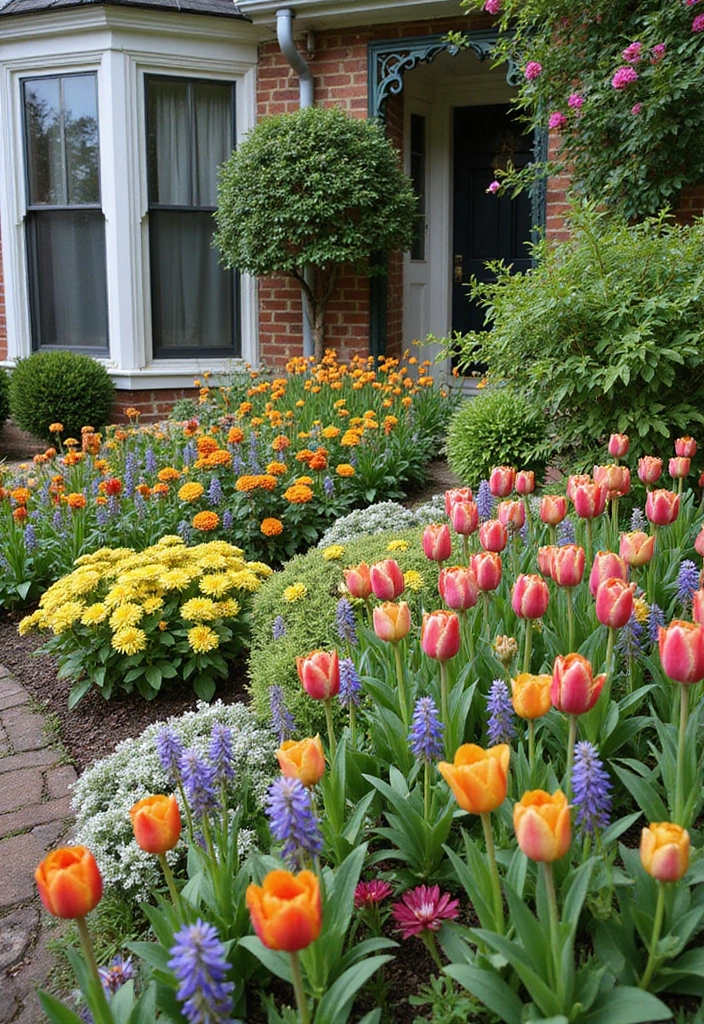
Victorian gardens are known for their vibrant flower beds overflowing with color and texture. Start by choosing a variety of ornamental plants including traditional favorites like peonies, dahlias, and hydrangeas. Layer heights for visual interest; taller plants at the back and shorter ones in the front create depth.
– Group plants in odd numbers for a natural look.
– Incorporate seasonal flowers for year-round beauty.
– Use rich soil amendments to ensure health and growth.
Each season brings a new palette; spring with tulips and summer with sunflowers. This approach not only brings life but also adds to the charm that defines Victorian gardens.
3. Decorative Garden Paths
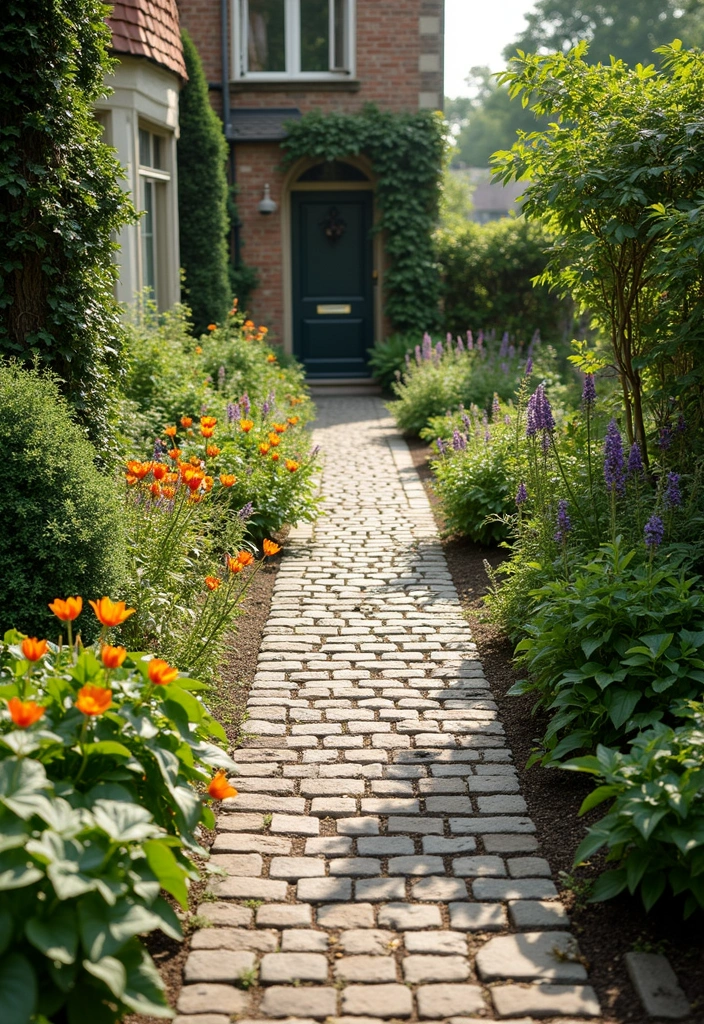
Garden paths are the veins of a Victorian garden, guiding visitors through its beauty. Opt for paths made of bricks, cobblestones, or gravel to create that old-world charm.
To enhance the visual appeal, include subtle curves in your path design, leading to focal points like a charming bench or a birdbath.
Key suggestions:
– Use contrasting materials to define the path.
– Line the edges with small flowering plants for a soft transition.
– Incorporate a few solar lights to illuminate the path at night.
A well-designed path not only provides structure but also invites guests to wander and explore your garden.
A charming Victorian front garden path isn’t just a way to get around—it’s an invitation to explore. Let your path lead to enchanting surprises, like a cozy bench or a whimsical birdbath!
4. Vintage Garden Decor
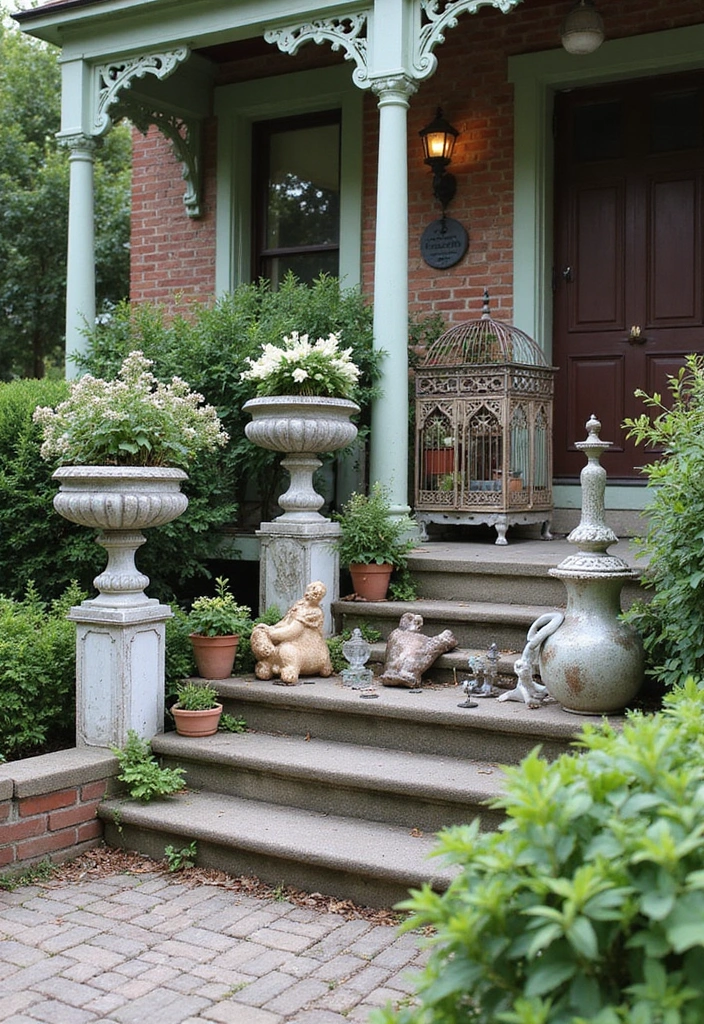
Adding vintage garden decor can infuse character and charm into your Victorian front garden. Think along the lines of antique birdcages, decorative urns, and whimsical metal sculptures. These pieces tell a story and serve as conversation starters.
Consider:
– Placing an old-fashioned watering can as a planter for herbs.
– Using vintage furniture like an ornate bench in a cozy nook.
– Hanging antique mirrors among the foliage to reflect light and create depth.
When choosing decor, let your personal style shine through. Mixing different eras can provide a unique touch while still maintaining the Victorian elegance.
5. Climbing Plants and Trellises
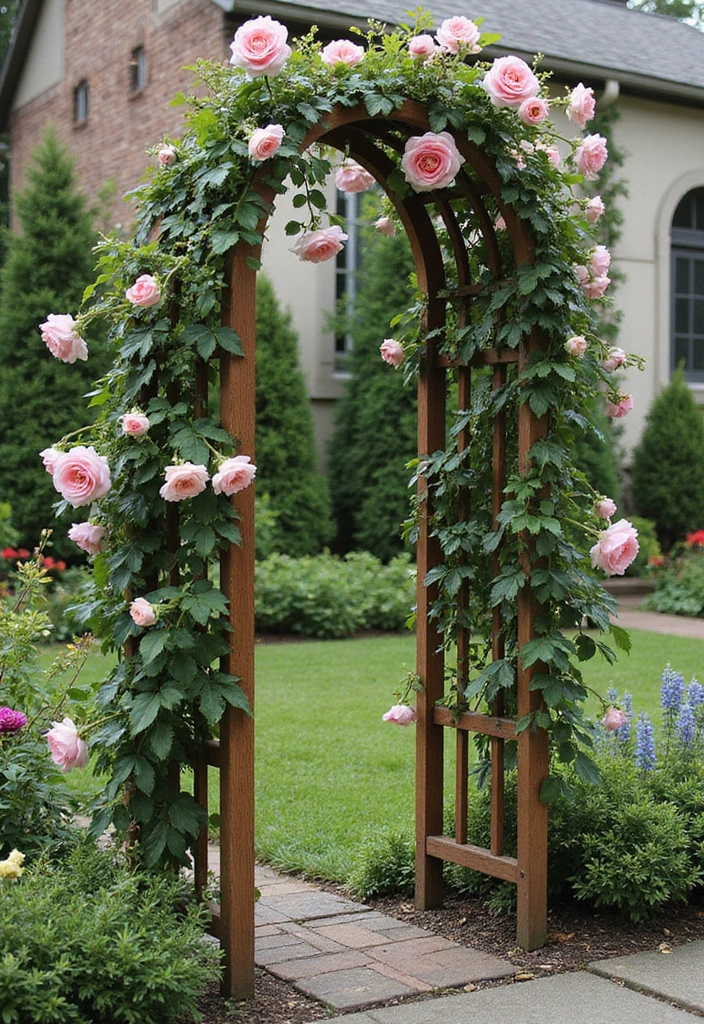
Climbing plants are quintessential in Victorian gardens. They add vertical interest and can transform blank walls or fences into lush green canvases. Use trellises to support climbing roses, clematis, or ivy, adding both beauty and fragrance to your space.
Key points:
– Select sturdy trellises that complement your other features.
– Train plants for a uniform look; consider color coordination.
– Ensure adequate sunlight for climbers to thrive.
Incorporating these elements will not only beautify your garden but also create a backdrop that changes with the seasons.
6. Statues and Fountains
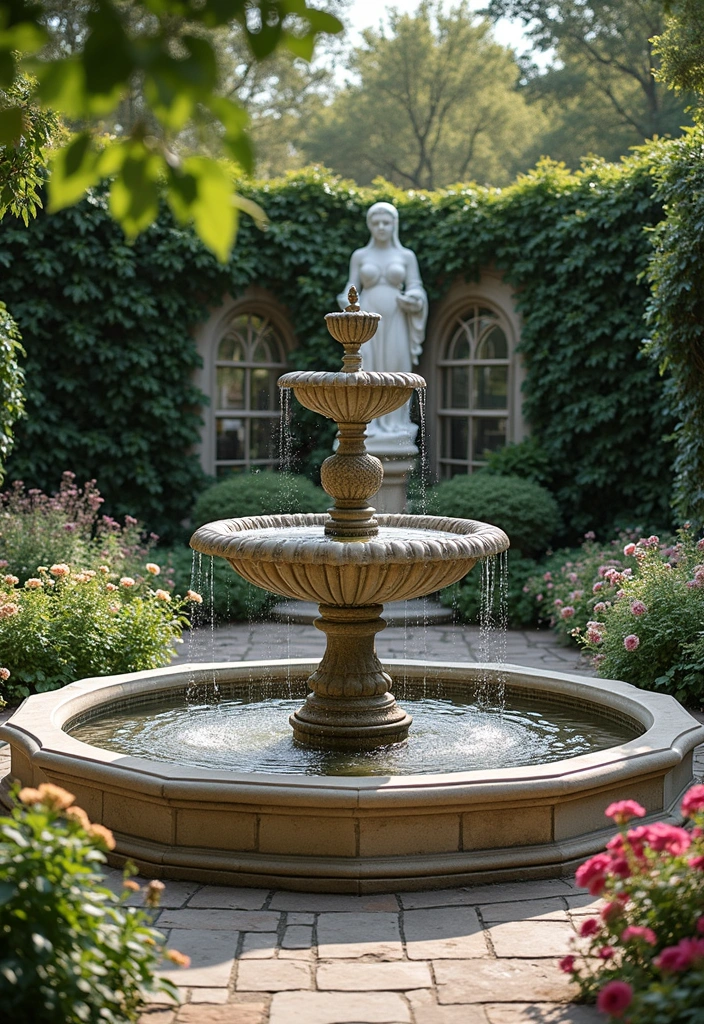
A classic Victorian garden often features statues or fountains as focal points. These elements add sophistication and a sense of history to your garden. Consider a small fountain that gently trickles water, creating a serene atmosphere.
Suggestions include:
– Choose statues that reflect Victorian-style motifs, like cherubs or classical figures.
– Position fountains in areas where they can be viewed from various angles.
– Surround them with flowers or lush greenery to create a natural frame.
These installations not only enhance visual appeal but also attract birds and create a peaceful ambiance.
7. Garden Benches
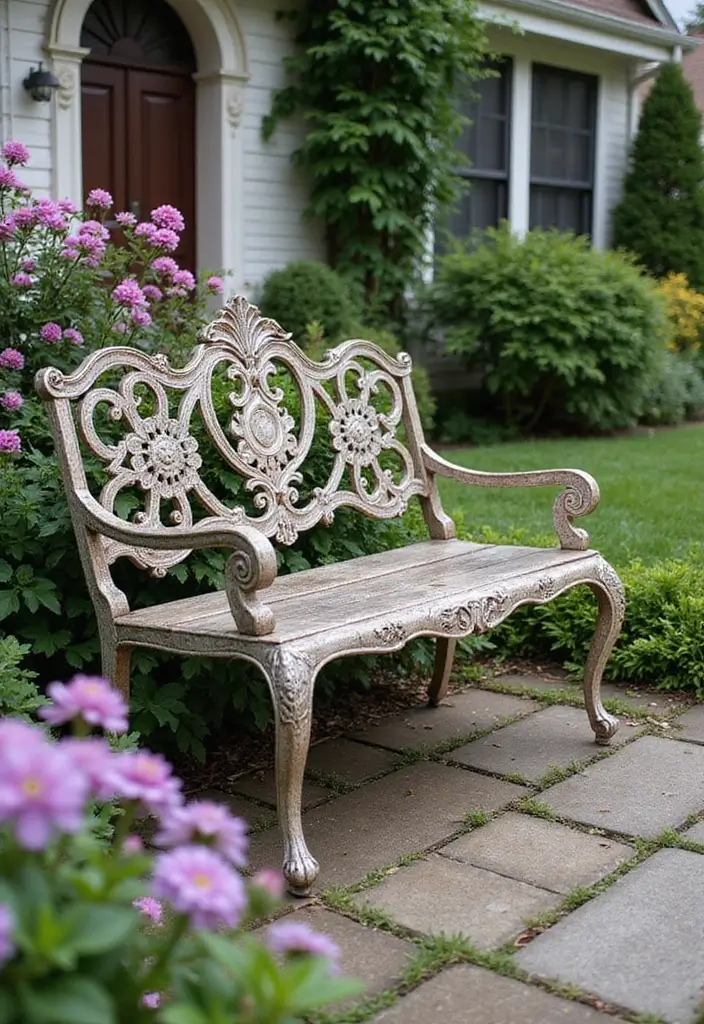
Incorporating a classic garden bench is a must for any Victorian front garden. These benches offer a spot to sit and enjoy the beauty around you, while also serving as a decorative element. Opt for wrought iron or carved wood to maintain that vintage feel.
Considerations:
– Position benches in shaded spots, perhaps under a tree or near climbing plants.
– Add colorful cushions for comfort and style.
– Strategically plant fragrant flowers nearby to create a sensory experience.
A well-placed bench invites not just relaxation, but also adds to the garden’s charm.
8. Seasonal Planting
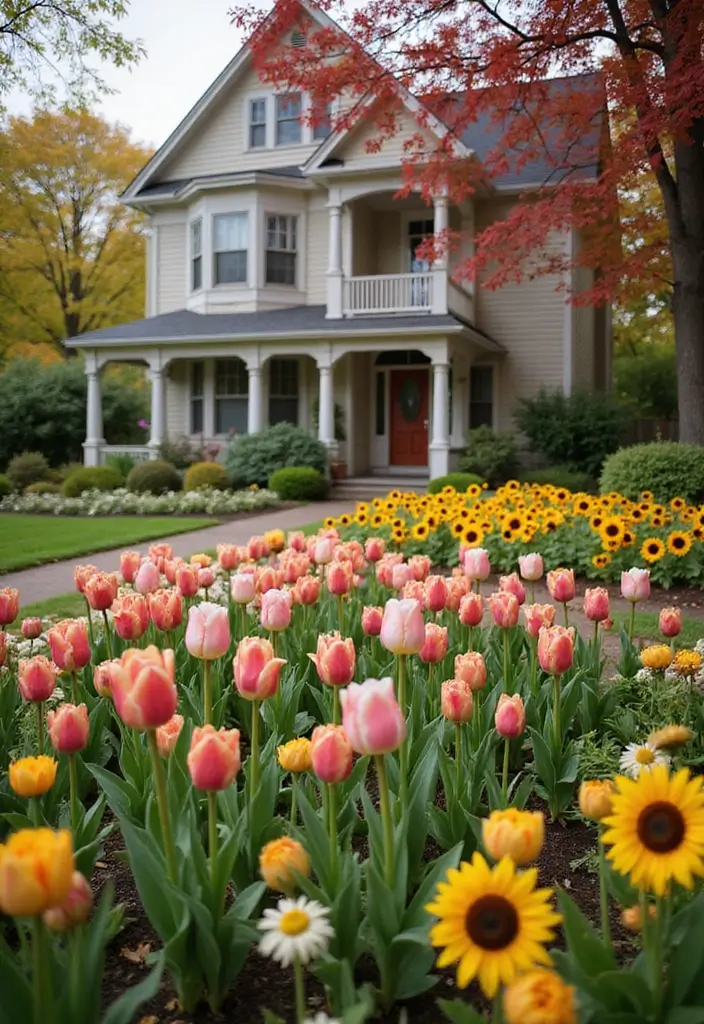
Embrace the Victorian enthusiasm for seasonal planting by rotating your flowers and plants throughout the year. This not only adds diversity but also keeps your garden lively. For spring, consider tulips and daffodils, while summer can be highlighted with sunflowers and roses.
Key tips:
– Create a seasonal planting calendar to track blooming times.
– Mix perennials with annuals for continual interest.
– Use bulbs for easy-to-care-for seasonal plants.
By ensuring a flow of colors throughout the seasons, you can have a constantly evolving front garden that captures attention all year round.
Seasonal planting is like giving your Victorian front garden a wardrobe change—refreshing and ever-evolving! Rotate blooms and embrace nature’s palette for a lively outdoor space all year long.
9. Herb Gardens
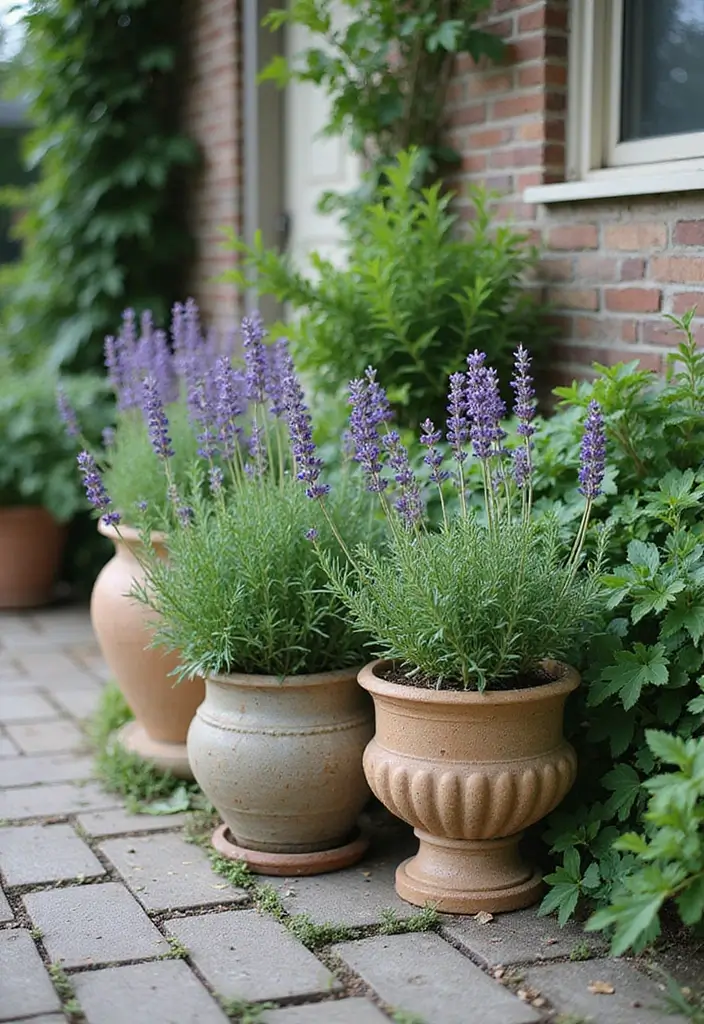
Incorporating an herb garden into your Victorian front garden can be both functional and beautiful. Herbs like lavender, rosemary, and sage not only smell amazing but can also be used in the kitchen. Use decorative pots or create a raised bed with rustic wood for that vintage feel.
for success:
– Position herbs in a sunny spot for optimal growth.
– Mix herbs with ornamental plants to maintain aesthetics.
– Consider using labeled stakes made of wood to identify the herbs.
An herb garden enhances both the beauty and utility of your outdoor space, making it a practical yet charming addition.
10. Colorful Container Gardens
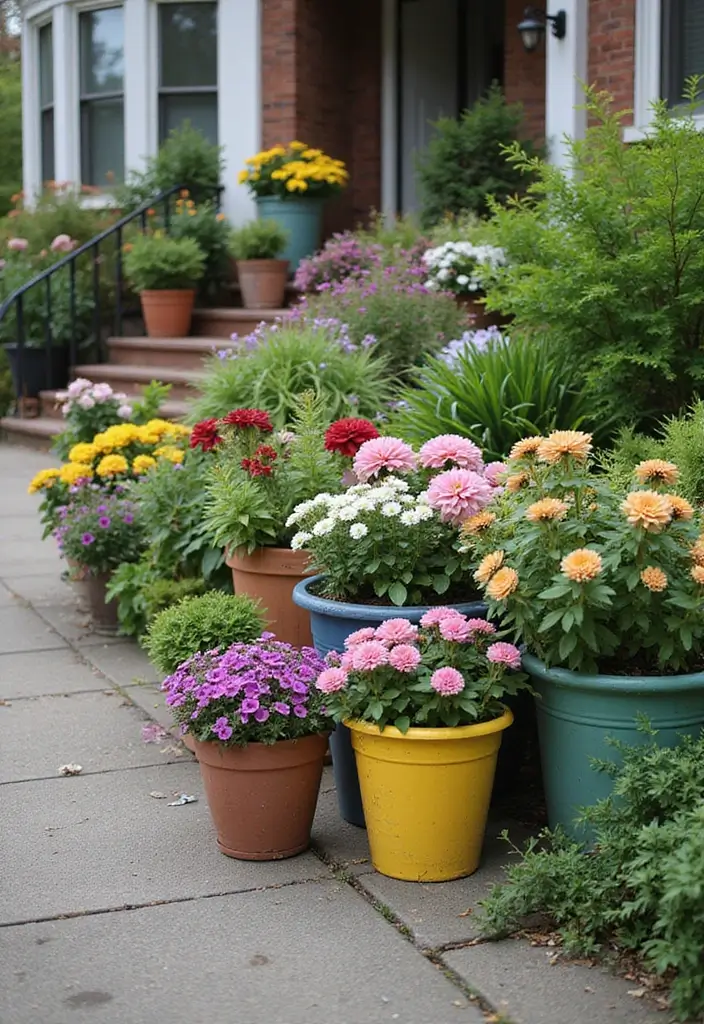
Container gardening is an excellent way to add Victorian charm to small spaces. Use an assortment of pots in varying shapes and colors to create visual interest. Choose a mix of flowers, ornamental grasses, and trailing vines for dynamic arrangements.
Considerations:
– Ensure proper drainage in pots to prevent root rot.
– Group containers together for a fuller look.
– Change out plants seasonally for ongoing color.
This approach allows for creativity, and with the right selections, your container garden can reflect the vibrant spirit of Victorian style.
11. Charming Arbors
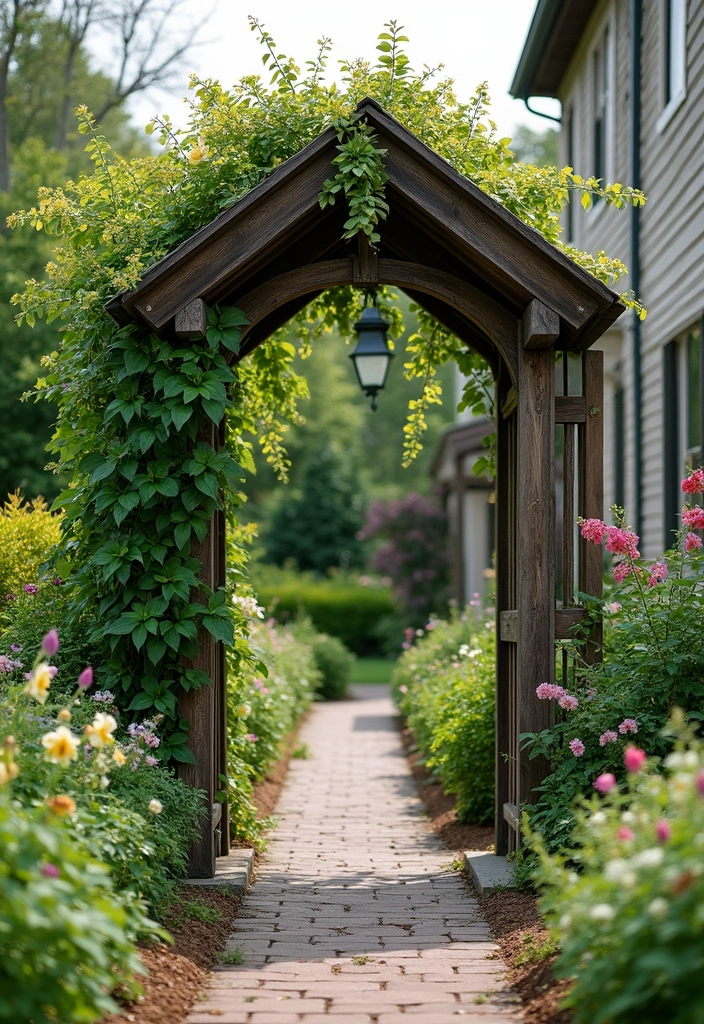
An arbor can act as a stunning entry point to your Victorian front garden. These structures can be adorned with climbing plants, providing a beautiful transition into your garden space. Choose wooden or wrought iron designs that echo Victorian architecture.
Key features to consider include:
– Positioning the arbor at the entrance to create a welcoming feel.
– Enhancing it with twinkling fairy lights for evening charm.
– Using seasonal climbing plants to change its look throughout the year.
An arbor is not just functional; it adds an enchanting feel that draws people into your garden.
12. Drought-Resistant Plants
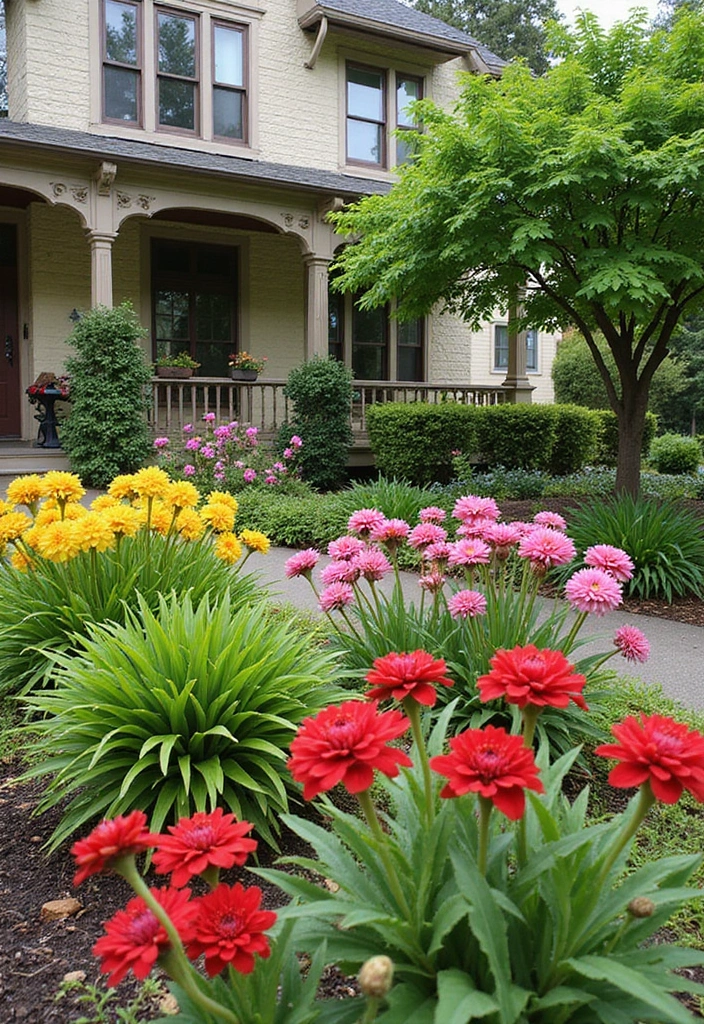
Choosing drought-resistant plants can enhance your Victorian garden while being eco-friendly. These plants require less water and can thrive in various conditions, making them perfect for busy gardeners. Consider varieties like lavender, succulents, and ornamental grasses.
Recommendations include:
– Grouping these plants together for a stunning visual display.
– Incorporating them into your garden design for easy maintenance.
– Choosing plants that bloom at different times for continuous interest.
Creating a garden that is beautiful and sustainable is a delightful combination for any Victorian enthusiast.
13. Victorian-style Gazebo
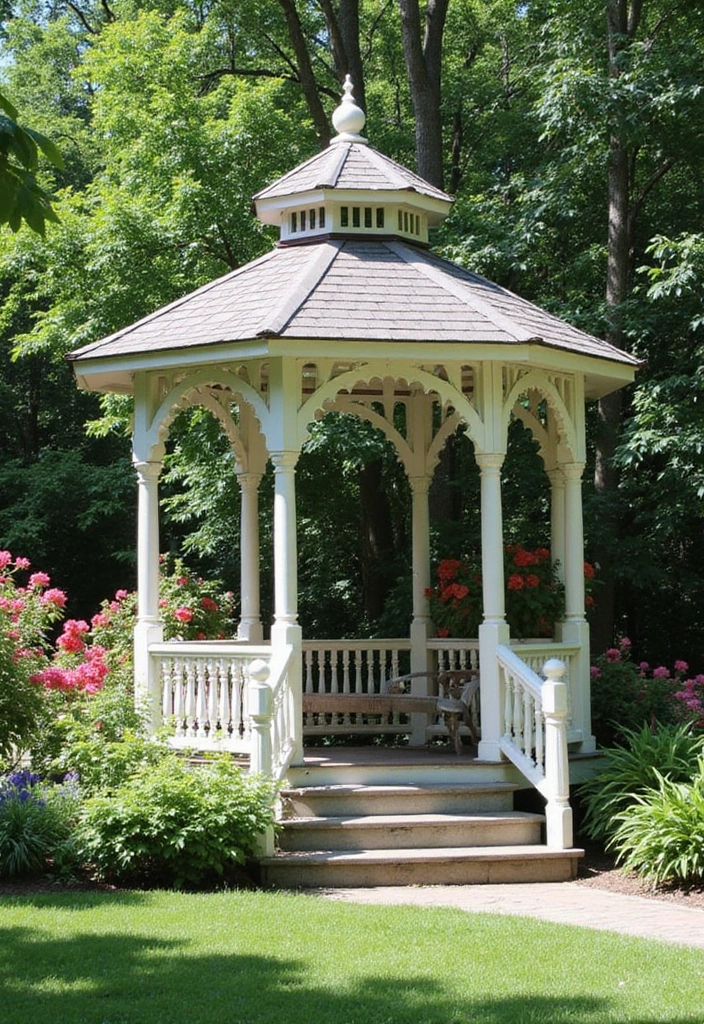
A gazebo is a stunning focal point that adds a touch of elegance to any Victorian front garden. Choose designs with intricate woodwork and ample seating to create a perfect relaxation spot. It’s not just beautiful; it can also be a functional space for gatherings.
Considerations:
– Position it to catch glimpses of the garden’s best views.
– Add climbing plants around it for a shaded retreat.
– Decorate with vintage furniture to maintain the Victorian theme.
Having a gazebo can turn your front garden into a delightful outdoor living area.
14. Pathway Lighting
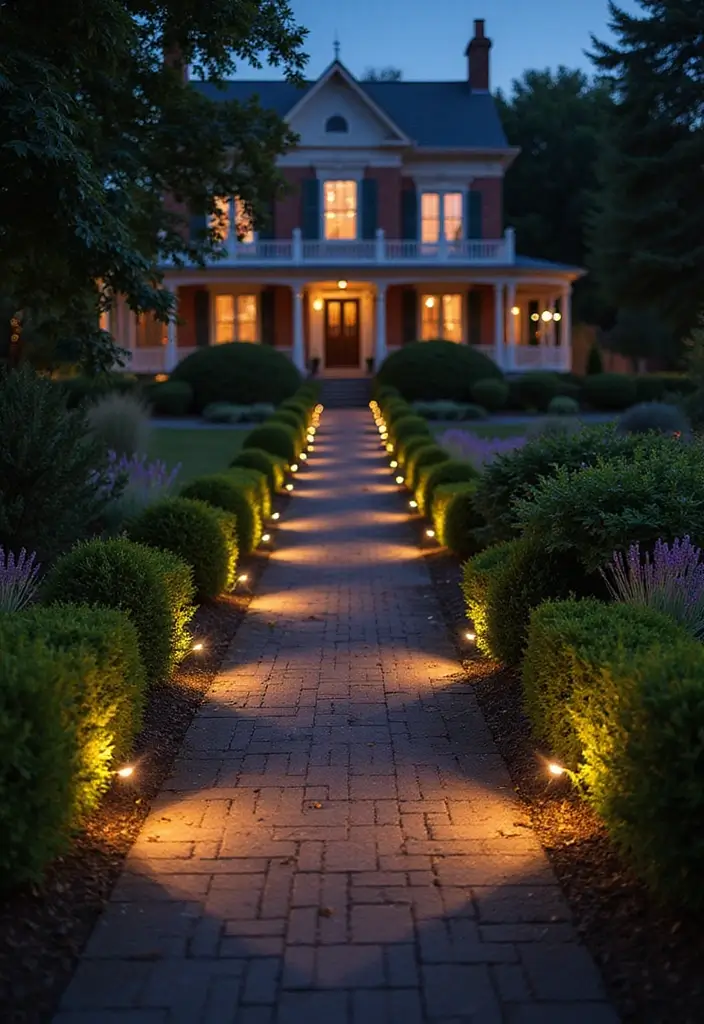
Adding lighting to your garden paths not only enhances safety but also creates a magical atmosphere at night. Consider using vintage-style lanterns or solar lights that echo the Victorian aesthetic.
– Position lights along the path to guide guests.
– Choose warm-toned bulbs for a cozy glow.
– Install lights near key features like statues or flower beds for added focus.
By incorporating pathway lighting, your front garden can become a fairytale setting as the sun sets.
15. Seasonal Decorations
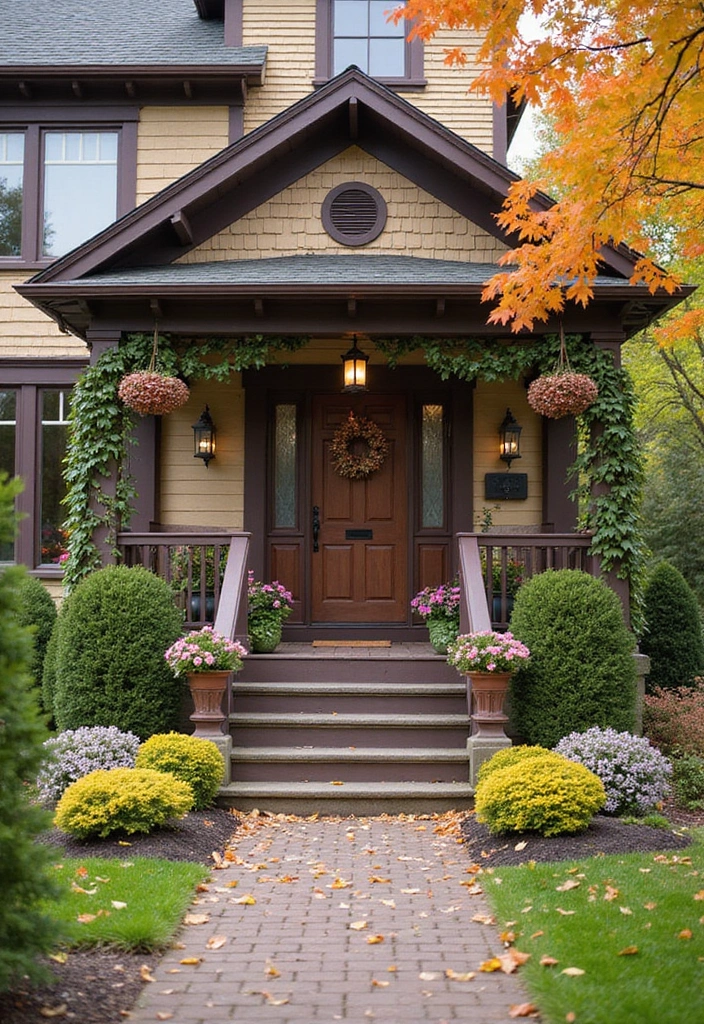
Seasonal decorations can enhance your Victorian front garden’s charm. From spring florals to autumn mums, changing decorations can keep your garden fresh. Use vintage decorations such as small flags or bunting that align with the season.
Suggestions include:
– Creating a theme for each season to unify decor elements.
– Using natural materials, like pumpkins in the fall or fresh blooms in spring.
– Considering color palettes that match the blooms in the garden.
This practice keeps your garden lively and engaging throughout the year.
16. Herb Spiral Garden
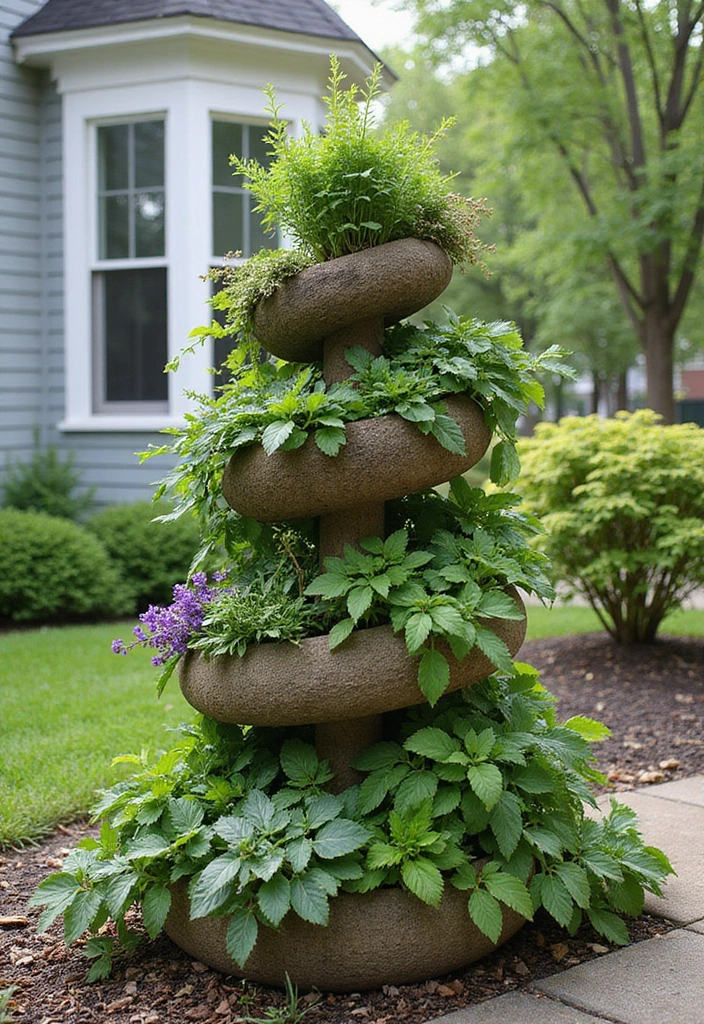
An herb spiral is a creative way to maximize your gardening space while incorporating the charm of a Victorian garden. This vertical garden design allows for various herbs to be grown in a compact area. It’s also a functional piece that can serve as a decorative centerpiece in your front yard.
– Choose herbs that thrive in different conditions; some love the sun, while others prefer shade.
– Use stone or brick to create the spiral structure for a classic look.
– Consider adding a small water feature at the top for added charm.
A herb spiral not only saves space but also invites gardening enthusiasts to explore all the different herbs it has to offer.
17. Victorian-Style Planters
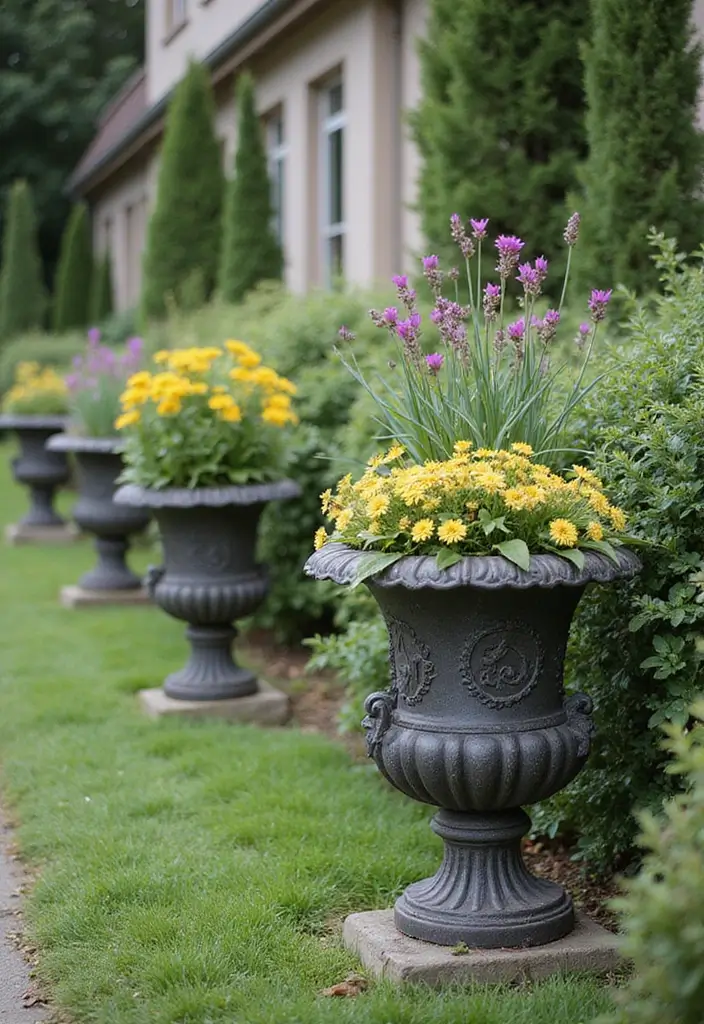
Opting for Victorian-style planters can add sophistication to your front garden. Choose ornate containers made from materials like ceramic, terracotta, or wrought iron. These planters can act as focal points or simple accents, depending on their placement.
Considerations:
– Use planters of different heights to create dimension.
– Decorate with trailing vines or colorful blooms.
– Ensure drainage holes for healthy plant growth.
Using stylish planters enhances the overall aesthetic and highlights your chosen plants.
18. Border Plantings
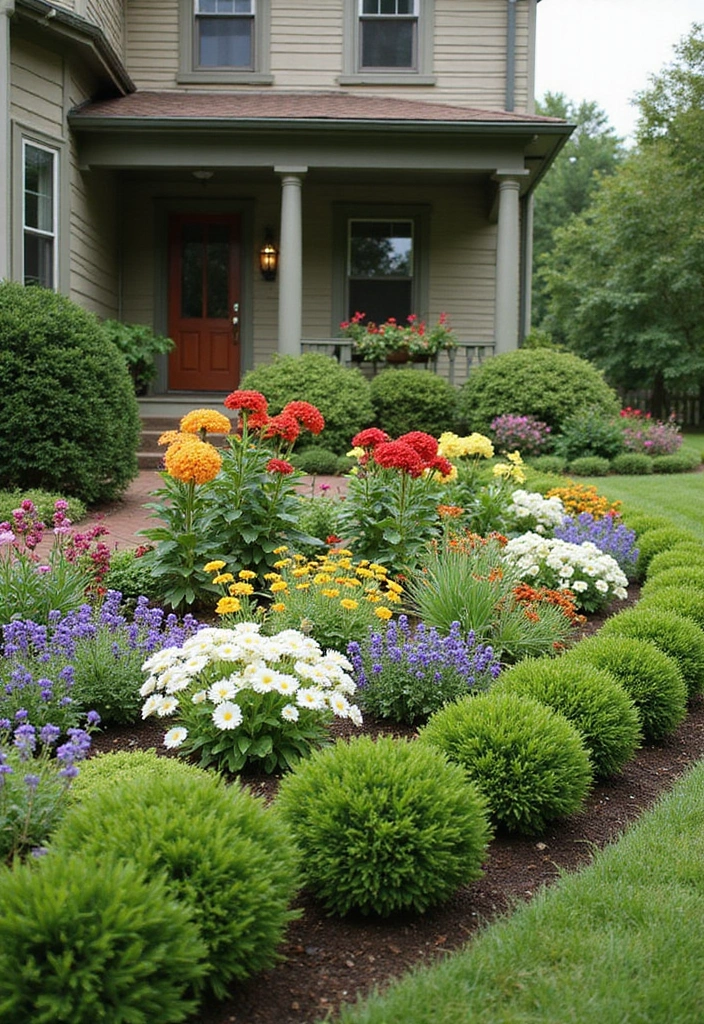
Creating border plantings around your front garden can define space while adding lushness. Use a mix of perennial and annual flowers, along with low-growing shrubs. This technique not only enhances the garden’s shape but also provides a vibrant frame for your flowers.
Suggestions:
– Choose plants that bloom at different times for ongoing visual interest.
– Maintain a color theme for a cohesive look throughout the seasons.
– Consider using small stones or bricks to define the borders.
Border plantings add structure and elegance, making your garden appear more polished.
19. Butterfly Gardens

Creating a butterfly garden is a fun way to add life to your Victorian front garden. Focus on planting flowers that attract butterflies, such as milkweed, zinnias, and lantanas. Not only does this invite these beautiful creatures, but it also promotes biodiversity.
Key considerations:
– Choose a sunny spot, as butterflies love warmth.
– Include diverse plantings for continuous blooms.
– Avoid pesticides to create a safe environment for butterflies.
This addition enhances the charm of your garden and creates a lively atmosphere filled with fluttering wings.
20. Victorian Garden Sculptures
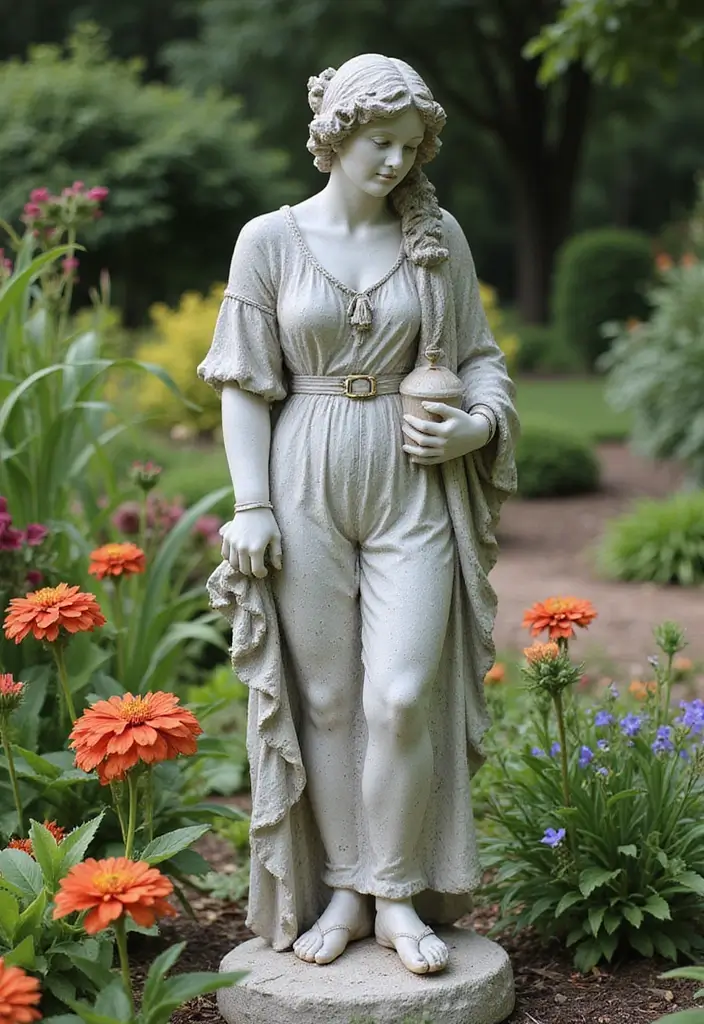
Incorporating sculptures can greatly enhance the allure of your Victorian front garden. Look for pieces that reflect Victorian art, such as angels, fairies, or classical figures. These sculptures can serve as captivating focal points amidst your flora.
Suggestions:
– Position sculptures where they can be easily viewed.
– Use contrasting plants to highlight the sculptures.
– Ensure materials are suitable for outdoor placement.
Sculptures bring a sense of storytelling and artistry to your garden, inviting guests to appreciate its elegance.
21. Leafy Green Backdrops
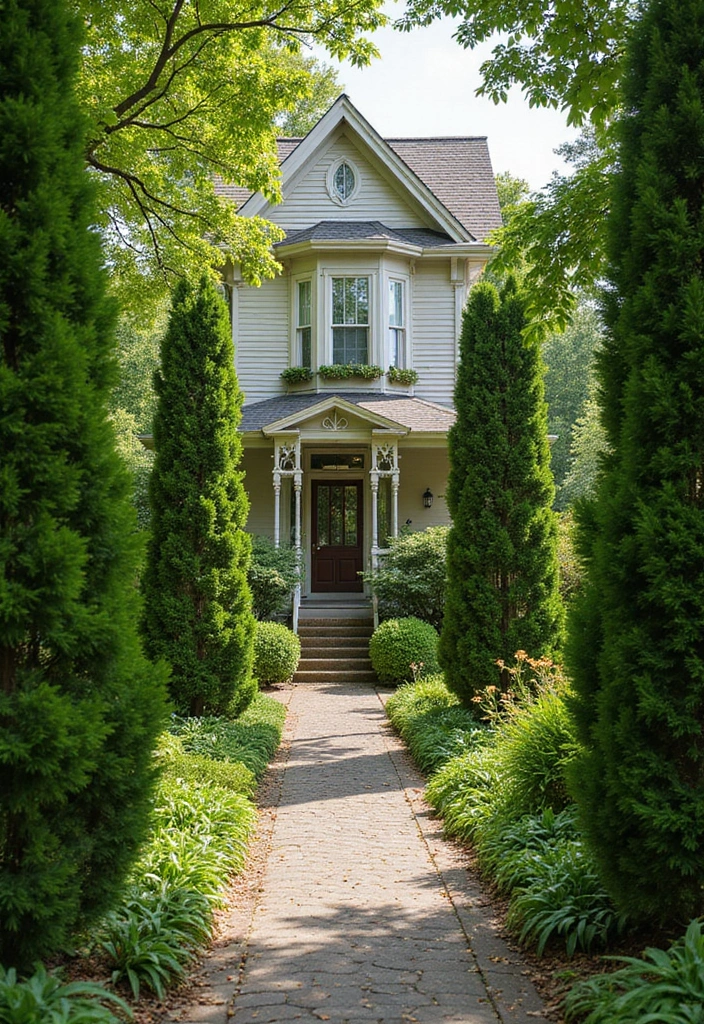
Creating a green backdrop is essential to any Victorian garden. Use tall shrubs or hedges to outline and frame your space, making an inviting environment. Focus on varieties that offer lush foliage and texture.
Key points:
– Choose evergreen plants for year-round greenery.
– Layer plants for a more dynamic look.
– Incorporate flowering shrubs for seasonal bursts of color.
A well-planned backdrop allows your vibrant flowers to shine through and creates a serene retreat.
22. Miniature Garden Spaces
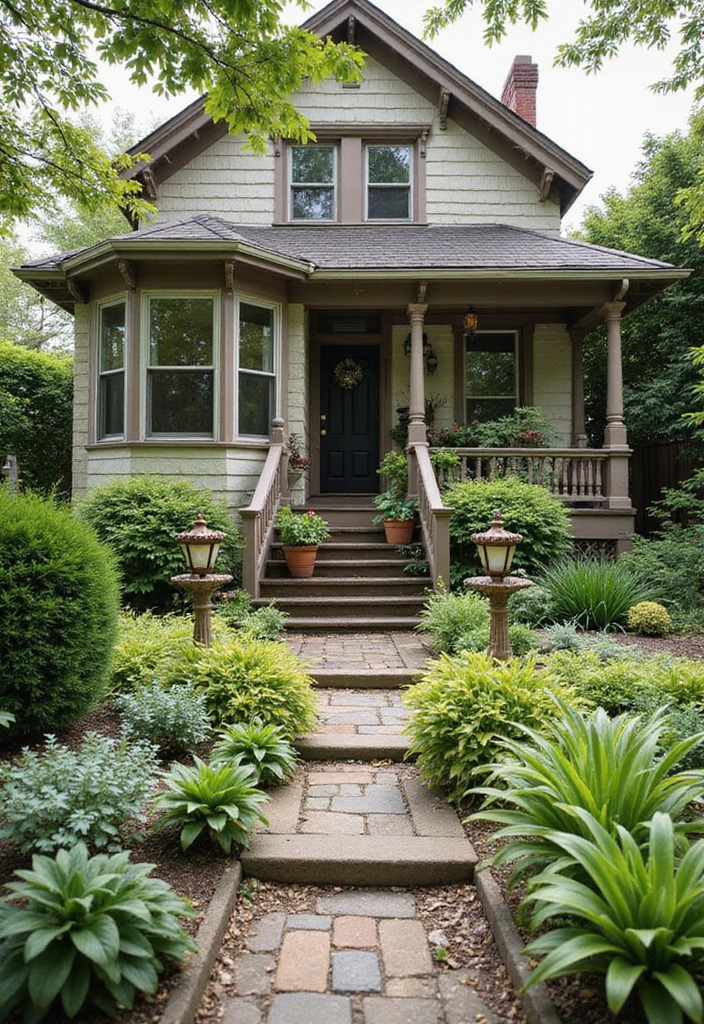
If space is limited, consider creating miniature garden spaces that still reflect Victorian charm. Use small decorative features such as tiny benches or bird baths, and choose plants that stay compact. These little pockets of beauty can add charm without overwhelming a small front yard.
Suggestions:
– Use small, colorful pots to house your plants.
– Incorporate decorative stones to add contrast.
– Create tiny pathways to guide the eye.
Miniature gardens offer creativity and can be a fun project for the whole family.
23. Enclosed Garden Spaces
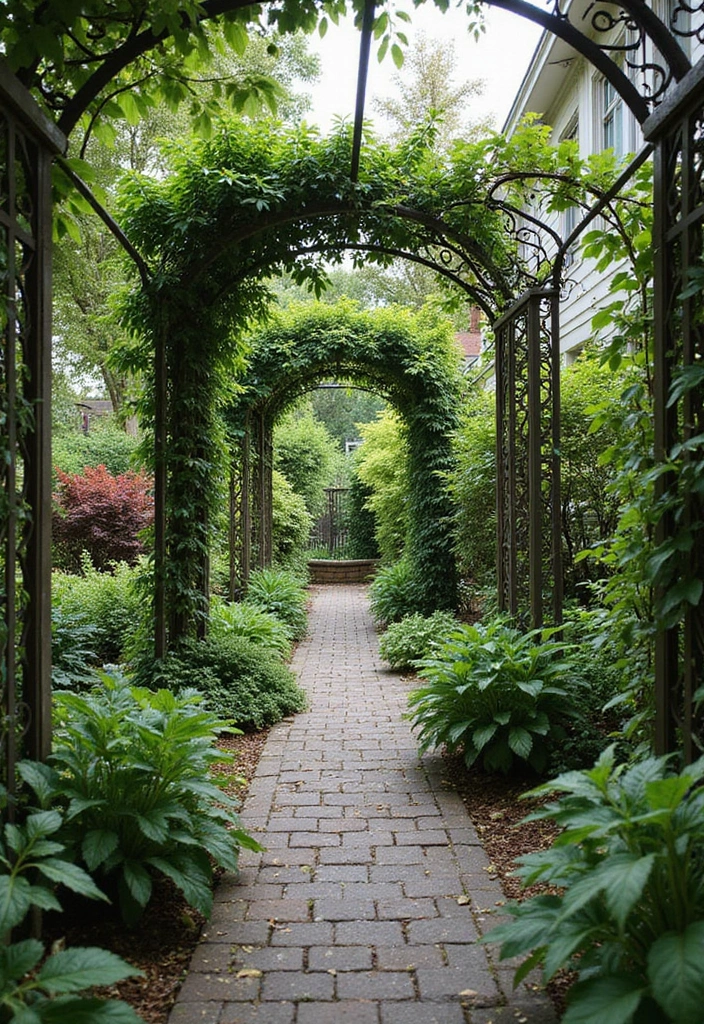
Creating an enclosed garden space with trellises or fencing can enhance the cozy feel of a Victorian front garden. This creates a serene retreat, perfect for enjoying quiet moments. Choose materials that align with traditional Victorian styles to maintain that timeless appeal.
Key features include:
– Positioning seating for relaxation.
– Lining the enclosure with fragrant plants for a sensory experience.
– Adding fairy lights for a magical ambiance.
This enclosed space gives a sense of intimacy while still being part of your larger garden.
24. Rock Gardens
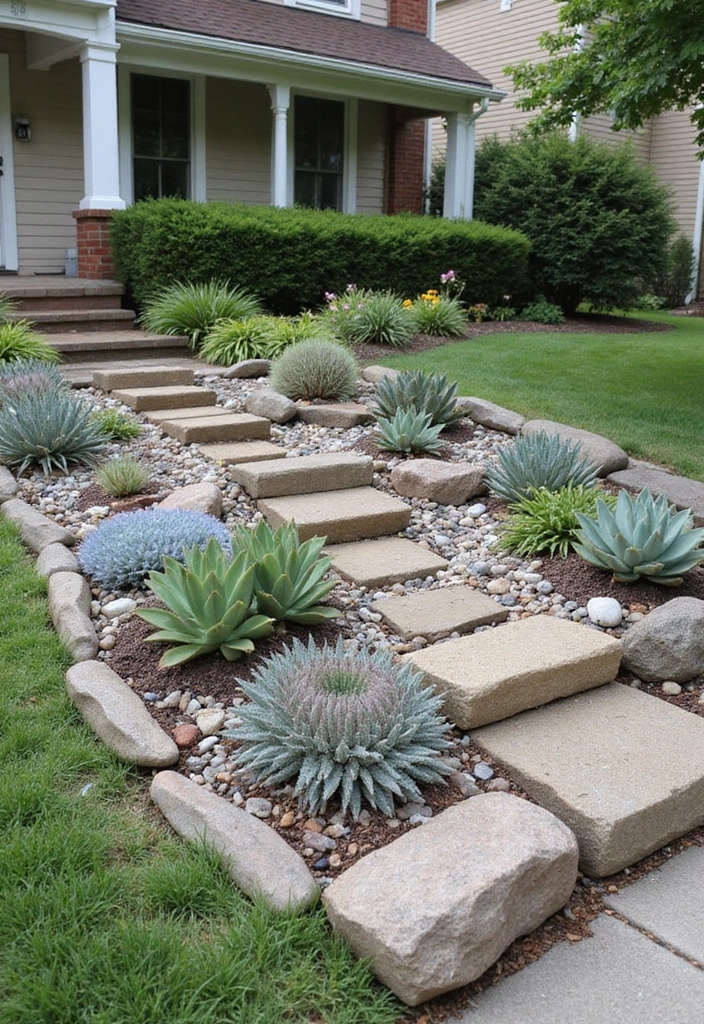
Incorporating a rock garden can add an interesting texture to your Victorian front garden. These gardens are great for showcasing succulents and drought-resistant plants while providing a unique aesthetic. Use natural stones to create pathways and borders, enhancing the old-world charm.
Consider:
– Choosing a mix of rock sizes for visual appeal.
– Planting ground covers to soften the stones.
– Incorporating a small water feature for added interest.
A rock garden provides a distinct contrast to lush greenery while still fitting within the Victorian style.
25. Wildflower Areas
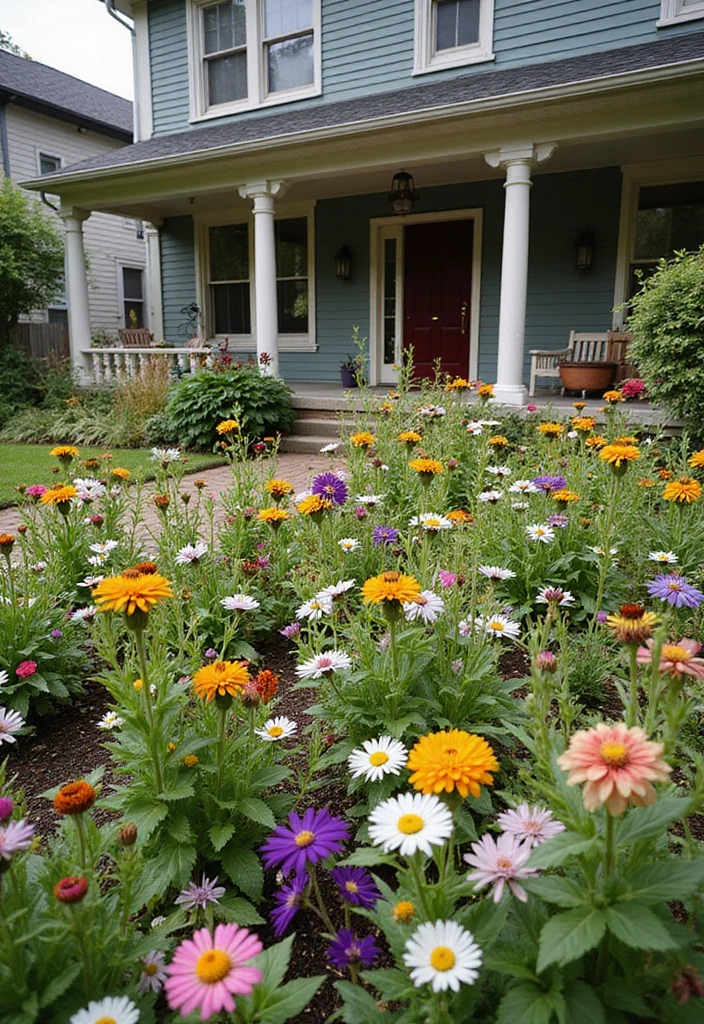
Creating a wildflower area can bring a natural, organic touch to your Victorian garden. Selecting native wildflowers not only adds color but also attracts pollinators and supports the ecosystem. To create this area, select a sunny patch and scatter seeds in the fall.
Suggestions include:
– Choosing a mix of colors and varieties to ensure blooms throughout the season.
– Leaving some areas unmowed to encourage natural growth.
– Incorporating paths for easy access.
Wildflower areas provide a carefree, charming look reminiscent of the Victorian appreciation for nature.
26. Seasonal Color Themes
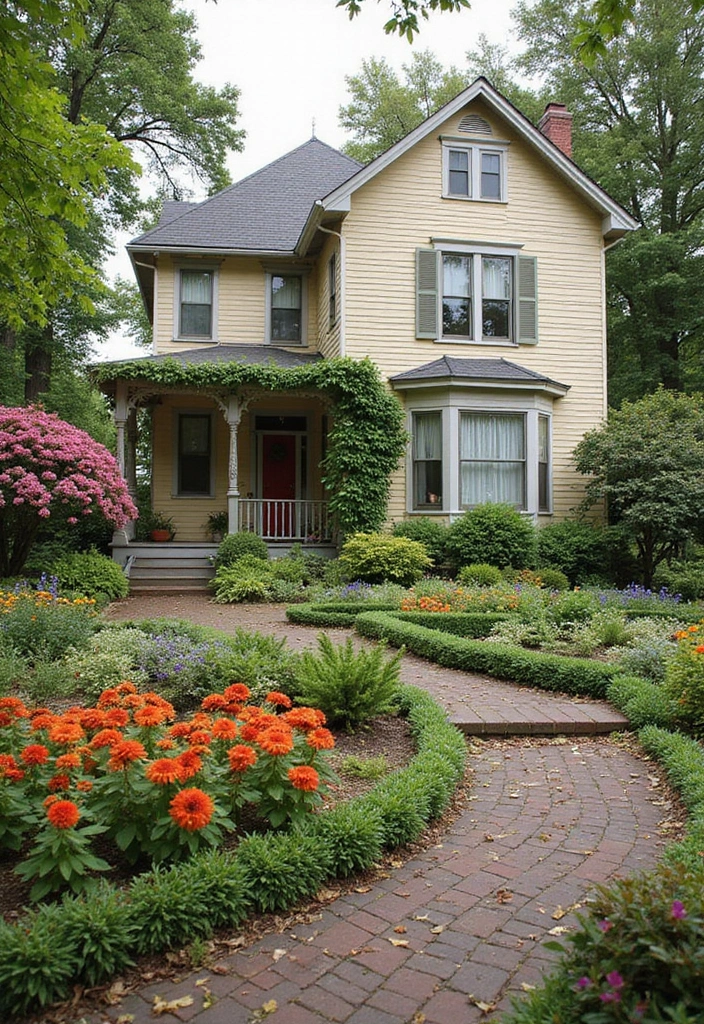
Implementing seasonal color themes can elevate the overall look of your Victorian front garden. By selecting plants that align with seasonal colors, you create a cohesive and enticing atmosphere. For spring, think pastels; for summer, vibrant hues; and for autumn, warm earthy tones.
Key suggestions:
– Create a planting plan that rotates color themes.
– Consider complementary colors for visual impact.
– Add decorative elements that resonate with seasonal tones.
This tactic helps your garden stand out and captivates viewers every season.
27. Vertical Gardens
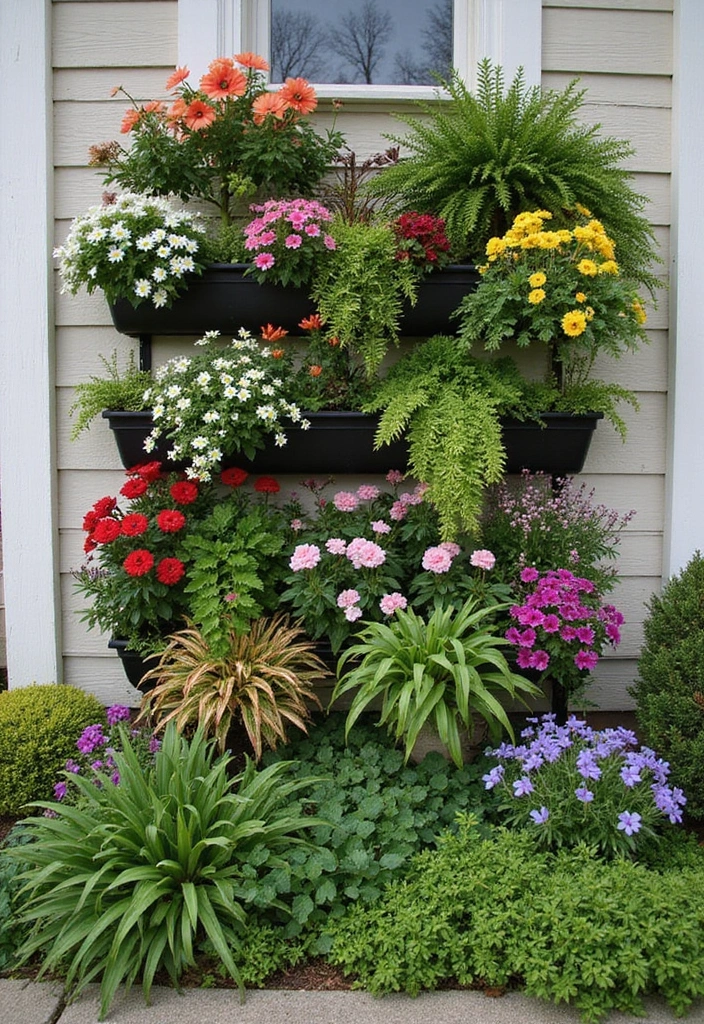
Vertical gardens are a great way to bring greenery to limited spaces while showcasing the Victorian love for lushness. Use trellises or wall-mounted planters to create stunning arrangements of flowers and herbs. This design not only saves space but also adds depth and texture.
Considerations:
– Mix different plant types for variety in height and color.
– Ensure adequate sunlight for all plants.
– Regular maintenance is key to keeping a vertical garden thriving.
This modern twist on traditional gardening can bring a fresh perspective to your Victorian style.
Vertical gardens are the perfect blend of form and function, allowing you to embrace your Victorian front garden dreams even in the tightest of spaces. Let nature climb your walls and transform your home with charm!
28. Elegant Path Edging
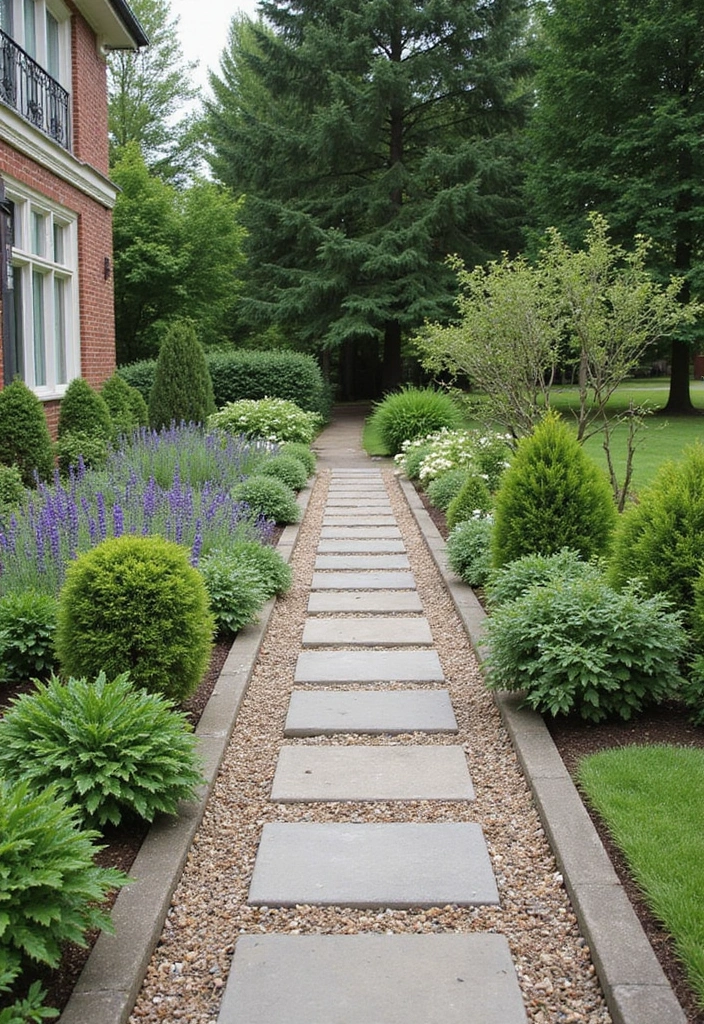
Using elegant path edging can elevate your Victorian garden’s overall aesthetic. Consider using brick, slate, or natural stones to define your pathways and create clear boundaries. Edging not only enhances the look but also keeps mulch and soil in place.
Key benefits:
– Creates a polished and well-maintained appearance.
– Helps prevent grass from encroaching on your paths.
– Offers a timeless appeal that complements Victorian architecture.
Path edging contributes to the charm and elegance that is synonymous with Victorian gardens.
Elegant path edging is not just decoration; it’s a defining line between chaos and charm in your Victorian front garden. Create pathways that invite and inspire, while keeping your garden’s beauty intact!
29. Garden Art
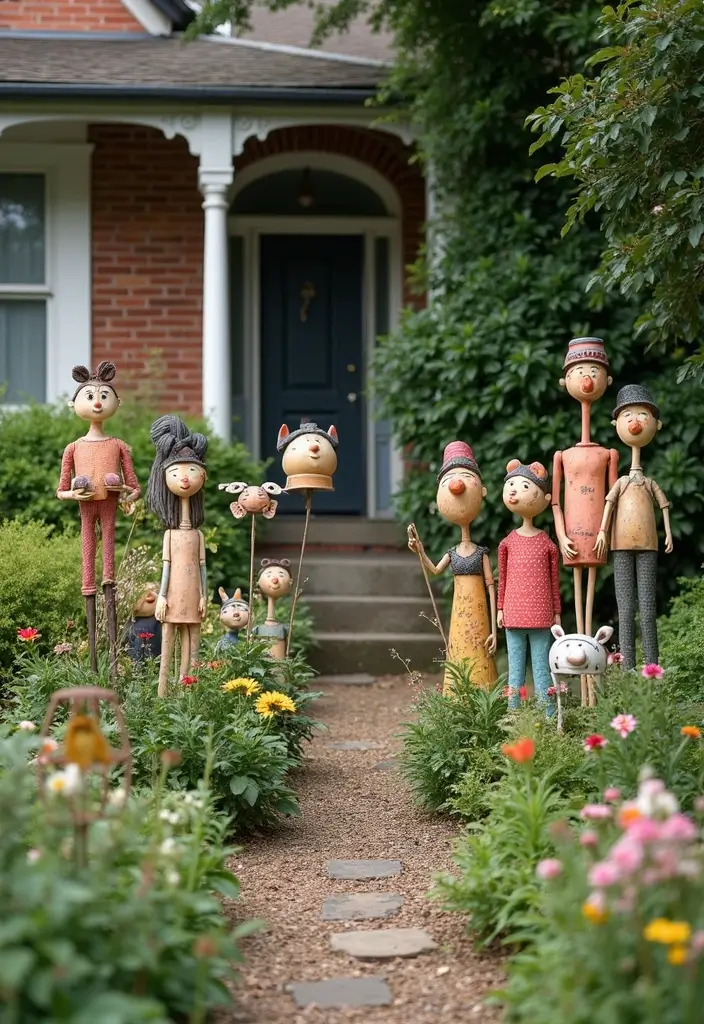
Incorporating unique garden art can further enhance the charm of your Victorian front garden. Look for pieces that reflect the Victorian era’s artistic sensibilities, such as pottery, colorful tiles, or intricate birdhouses. These elements can add personality and flair.
Suggestions:
– Choose art pieces that resonate with your garden theme.
– Ensure they are weather-resistant for longevity.
– Position them in visually interesting spots to draw the eye.
Art contributions introduce a personal touch and can transform a garden from ordinary to extraordinary.
30. Cozy Seating Areas
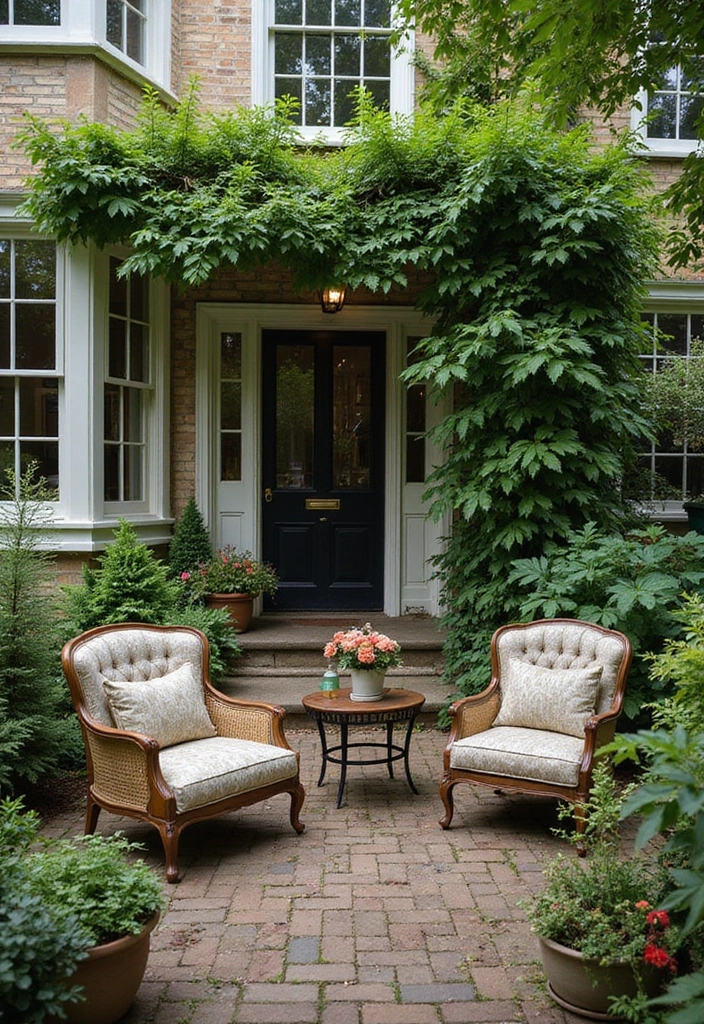
Creating cozy seating areas is essential for any Victorian front garden. These spots invite relaxation and should be strategically placed to take advantage of your garden’s beauty. Utilize vintage furniture, such as wrought iron chairs and tables, to maintain the Victorian style.
Key elements to consider:
– Place furniture in shaded areas for comfort.
– Surround seating with fragrant plants for an inviting atmosphere.
– Add cushions or throws for added comfort.
These areas serve as perfect spots to enjoy your garden, read a book, or simply sip tea, embodying the Victorian ethos of leisurely garden enjoyment.
Conclusion
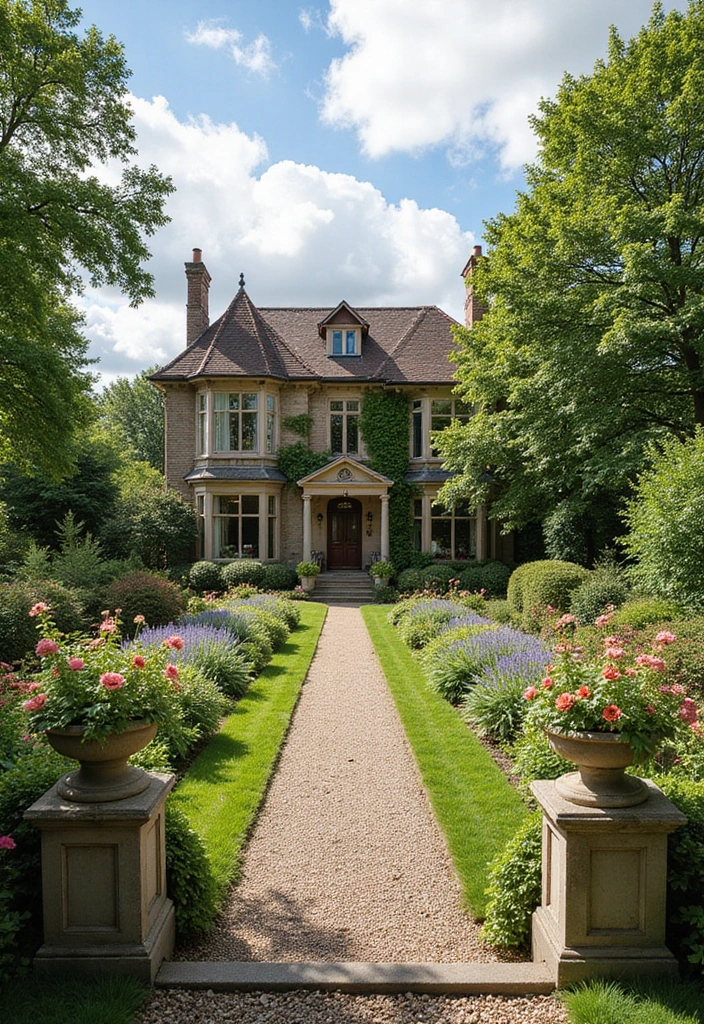
Designing a Victorian front garden can be a rewarding endeavor that reflects your unique style and love for timeless charm. By incorporating a mix of classic and modern elements, your small space can radiate elegance and allure. Each idea discussed here offers something special, whether it’s the lush flower beds or the ornate garden decor.
With a little creativity and care, your front garden can become a stunning representation of Victorian beauty that you’ll enjoy all year round.
Frequently Asked Questions
What are the key elements of a Victorian front garden design?
A Victorian front garden design typically includes ornate wrought iron fencing, vibrant flower beds, and decorative garden paths. These elements come together to create a charming and elegant atmosphere that reflects the opulence of the Victorian era. Don’t forget to incorporate climbing plants and vintage garden decor to enhance the overall aesthetic!
How can I make a small Victorian front garden look more spacious?
To create the illusion of space in a small Victorian front garden, consider using vertical gardening techniques such as trellises or wall-mounted planters. Incorporate colorful container gardens and create cozy seating areas to draw the eye around the space. Using lighter colors for garden paths and decor can also help make the area feel more open and inviting!
What types of plants are best for a Victorian front garden?
For a stunning Victorian front garden, opt for ornamental plants like peonies, dahlias, and foxgloves. These flowers not only add vibrant color but also reflect the Victorian love for lush gardens. Incorporating drought-resistant plants can also be beneficial, ensuring your garden remains beautiful with less maintenance!
How can I incorporate vintage decor into my Victorian front garden?
Adding vintage garden decor is a fantastic way to enhance the charm of your Victorian front garden! Look for items such as antique birdcages, decorative urns, and whimsical metal sculptures. These elements can serve as focal points and create a nostalgic feel that transports you back to the elegance of the Victorian era.
What are some practical tips for maintaining a Victorian front garden?
Maintenance of a Victorian front garden involves regular tasks like seasonal planting to keep your garden fresh with diverse blooms throughout the year. Ensure you prune climbing plants to encourage healthy growth and a neat appearance. Also, keep an eye on your garden paths to ensure they remain clear and inviting, adding to the overall charm of your garden!
